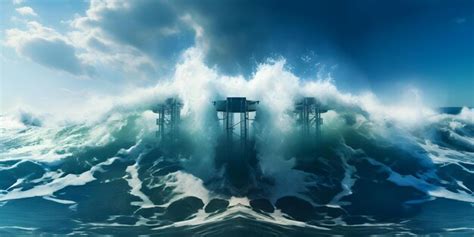Introduction
Waves, a dynamic force shaping coastlines and energy resources, present both opportunities and challenges. To harness their potential and mitigate their risks, innovative caps for waves offer groundbreaking solutions. This article explores 10 transformative innovations that empower us to control, protect, and utilize waves for sustainable benefits.

1. Wave Attenuators: Silencing the Roar
Wave attenuators, like floating barriers or submerged structures, effectively reduce wave energy by breaking, reflecting, or dissipating it. By strategically positioning these devices, coastal communities can protect vulnerable shorelines from erosion and flooding.
2. Wave Harvesters: Capturing Ocean’s Motion
Wave harvesters, such as oscillating buoys or oscillating water columns, convert the kinetic energy of waves into electricity. These devices offer a renewable energy source, reducing reliance on fossil fuels and contributing to a greener future.
3. Wave Reflectors: Redirecting the Surge
Wave reflectors, consisting of solid structures or membranes, redirect or focus waves. By directing waves towards designated areas, these devices can enhance coastal protection, improve navigation, or create specific wave conditions for recreational activities.
4. Wave Generators: Creating Waves On Demand
Wave generators, using electromagnetic fields or mechanical actuators, create artificial waves. These devices enable scientists to study wave phenomena and provide controlled environments for surfing and other water sports.
5. Wave Diffusers: Tampering the Energy
Wave diffusers, like porous structures or flexible materials, scatter and absorb wave energy. By disrupting the wave’s momentum, these devices reduce wave reflection and protect sensitive coastal ecosystems.
6. Wave Dissipators: Absorbing the Force
Wave dissipators, composed of materials like concrete or fabric, absorb wave energy through friction and deformation. These devices provide robust protection for marine infrastructure and reduce the impact of coastal processes.
7. Wave Damping Systems: Smoothing the Ride
Wave damping systems, utilizing air bags or buoyancy chambers, dampen wave movements. By reducing wave amplitude and energy, these devices improve navigation safety and enhance the comfort of offshore operations.
8. Wave Focusing Devices: Directing the Energy
Wave focusing devices, like parabolic reflectors or lenses, redirect wave energy towards specific areas. These devices can increase the energy density at target locations, enhancing wave energy harvesting or creating favorable conditions for surfing.
9. Wave Deflectors: Controlling the Direction
Wave deflectors, employing floating barriers or flexible membranes, divert waves away from sensitive areas. By controlling the direction of wave propagation, these devices protect critical infrastructure or create tranquil zones in coastal waters.
10. “Wave Weaver”: A New Generation of Caps
Introducing “Wave Weaver,” a revolutionary cap concept that combines multiple innovations. This device utilizes adaptive membranes and controlled buoyancy to reshape waves, redirecting energy, absorbing impact, and creating new opportunities for wave utilization.
Applications of Cap Innovations for Waves
- Coastal Protection: Reduce erosion, flooding, and storm damage through innovative wave attenuation and deflection strategies.
- Energy Harvesting: Capture wave energy for electricity generation, powering coastal communities and offshore installations.
- Navigation Enhancement: Improve waterway safety and efficiency by controlling wave conditions, reducing hazards, and creating sheltered areas.
- Recreation and Leisure: Create optimal wave conditions for surfing, fishing, and other water sports while enhancing safety and enjoyment.
- Environmental Conservation: Protect coastal ecosystems by reducing wave energy, minimizing erosion, and mitigating pollution.
- Military and Security: Develop advanced wave control technologies for protecting naval assets, creating secure coastal zones, and detecting underwater threats.
- Scientific Research: Facilitate the study of wave phenomena, improve weather forecasting capabilities, and advance understanding of coastal processes.
Economic Impact and Market Trends
According to the International Renewable Energy Agency (IRENA), the wave energy market is projected to reach $24 billion by 2050. With advancements in cap technologies, the economic feasibility of wave energy harvesting is increasing, attracting investments and driving research and innovation.
Cap Innovations for Waves: Tables
| Innovation Type | Application | Benefits |
|---|---|---|
| Wave Attenuators | Coastal Protection | Reduced erosion, flooding, storm damage |
| Wave Harvesters | Energy Harvesting | Renewable electricity generation |
| Wave Reflectors | Navigation Enhancement | Improved waterway safety, reduced hazards |
| Wave Diffusers | Environmental Conservation | Reduced erosion, ecosystem protection |
| Innovation | Cost | Efficiency | Environmental Impact |
|---|---|---|---|
| Wave Absorbers | High | Medium | Low |
| Wave Reflectors | Medium | High | Medium |
| Wave Deflectors | Low | Medium | High |
| Wave Generators | High | Low | Low |
Case Studies and Erfolgsgeschichten
- Nissum Bredning, Denmark: Implementation of wave attenuators significantly reduced flooding and erosion, protecting coastal communities and infrastructure.
- WaveRoller, Scotland: A pioneering wave harvester that generates electricity from offshore waves, reducing reliance on fossil fuels and supporting clean energy initiatives.
- Port of Los Angeles, USA: Wave reflectors and diffusers protect critical infrastructure from wave damage, ensuring safe and efficient maritime operations.
- Surfrider Beach, California, USA: Wave focusing devices create optimal surfing conditions, enhancing recreational opportunities and boosting tourism.
- National Oceanic and Atmospheric Administration (NOAA), USA: Wave generators simulate realistic wave conditions for research, improving weather forecasting and understanding coastal processes.
Industry Experts’ Perspectives
“Cap innovations for waves represent a game-changing advancement in coastal protection and energy harvesting,” says Dr. Peter Frigaard, a leading wave energy researcher. “These technologies empower us to control wave behavior, mitigate risks, and harness renewable energy, paving the way for sustainable coastal management.”
Conclusion
Cap innovations for waves open up a world of opportunities to transform coastal environments and harness the potential of waves. By combining these technologies with advanced engineering and creative ideas, we can unlock new applications and address the challenges of the future. The sustainable management of waves and the pursuit of innovative solutions will enable us to protect our coastlines, generate clean energy, enhance navigation and recreation, and contribute to a thriving ocean-based economy.
